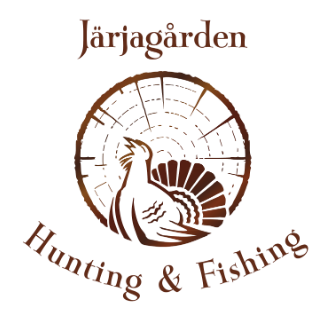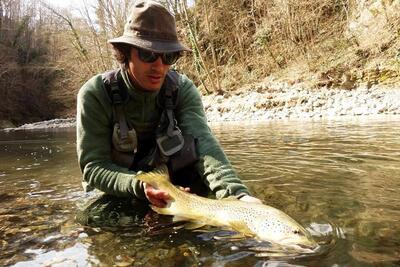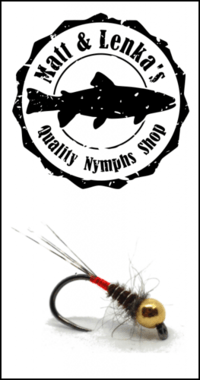It’s 1:30 a.m. on Tuesday 26th of June and we started to drive 7 hours earlier with my mate Olivier, heading north from Stockholm airport. The quick meal at the beginning of the trip seemed so far away. Even though the remaining high luminosity under those latitudes is an ally of choice in this situation, we needed a break. Since a couple of kilometres, the straight asphalt highway changed into a small winding road in the middle of a pine and spruce forest. It ended up becoming a gravel track as we came closer to our destination. The exotic atmosphere of this Nordic migration rushed through our veins.
We finally arrived at our lodge around 2 a.m., after a long 700 kilometres drive. We quietly walked through the entrance, with hope to find some indications to gain our rooms and not disturb our hosts. As soon as I get in, I felt the rustic vibes, provided by the deer antlers used as drying rack for waders. They made the place familiar. A few seconds later, we were welcomed by Alban Regnoult, the manager of Lappland Pro Natur, badly awake, gaily coloured apparent underwear, making this first contact rather original. His fishing camp for pike is just next door and he is in charged to introduce us to our Lapland hosts, Micke, Majelis and their daughter Sandra. She apparently hasn’t been scared of Alban, murky bearded provincial (from South of France).
The next morning, Alban had to leave us because it was the peak season for pike angling, but we set up a meeting for 3 days later, hoping for some fishing in our company. Micke is conformed with my vision of the Nordic head of the household. Not very emotional, straight look and prominent muscles are what I mean. He briefed us about the fishing sections and access to the very close Vojman River. He also gave us detailed maps where figured all the forestry roads. He gently took the time to come and show us the first spot. He said that the season was a little bit late this year, due to abundant snowfall during winter. Which is a good thing considering the heatwave from last summer. Because of that, the river was high and cold, but it shouldn’t affect the classic spring hatches that are making this area famous. We targeted mainly endemic grayling. Trout density is quite small therefore it’s mostly a matter of big fish caught with lures on this particular river. Not the kind of fishing I’m interested in anyway.
At 11a.m., this first morning, we were finally ready to start. The river is stunning, powerful and at least 40 m wide. With its dark water and big granitic rocks, it reminded me of the Allier River in France, but more impressive, though. By the look of the riparian grass, the level was definitely high. We slowly went down along the bank for a few minutes before to pick a spot. Olivier and I took 50 m apart from each other. I decided to start with a heterogeneous section including an island and 2 arms with wide-ranging profiles. It should provide enough information about the fish positioning. Mayflies are drifting in the current and there is a broad variety of different species. Some of them look like the Ephemera danica we find in France and they take off gently from the surface. Just upstream from a deep pool made by the island, a fast current got my attention. I cast my nymphs tandem and within a few drifts, medium size graylings take turns. There is no doubt on the density anymore. Amongst them, two trout with dark marking, typical from Northern Europe.
I decided to prospect both arms of the island. The one on the right had a lower level and I didn’t see anything. On the other side, there is a long pool with a powerful white-water head. The ratio speed/depth was changing progressively until reaching death on a deep and very slow flat. A few fish were rising at the tail of the pool. I started as far down as possible because of the important depth close to the bank with this level. That’s when I understood why we’ve been given safety life jackets. The current is strong, the water colour is dark, and the substratum is unstable, making wading very technical and dangerous. Therefore, even for the fittest, a wading stick is necessary.
The middle section of the pool didn’t bring me any results but going upstream in the fastest current brought the first bites. This logic followed us for the whole duration of the trip. If you want to hook graylings with nymphs or underwater, you will have to look for the currents with the higher speed/depth ratio. Focus on the main fast currents, even those which look too violent is a key and you would be surprised to see where the graylings are feeding.
I joined my mate Olivier who also caught fish on nymphs after trying to prospect, blind fishing with a dry without results. Our observations were similar: Lapland graylings, even more than their French cousins, prefer the main current of the river.
Around 1p.m., we took a much-appreciated lunch break made by our hosts. It was also our first introduction with the local mosquitos which had spared us until now. After the meal, we headed back to the game, hunting for rises on the flat just upstream. Some graylings are already rising. The fly choice was tough because of the amazing insect’s variety drifting on the surface. The rises are sporadic, and the high level doesn’t make things easier. Olivier reckons that a good presentation and a drag-free drift are much more important than the fly choice in those conditions. The fish gave proved him right and he caught a few in a row while fishing three quarter downstream with small ginger caddis in sizes 14 and 16. There was no doubt that with a lower level, fishing opportunities would be fantastic. It was mostly due to the incredible quantity of mayflies hatching during our trip. For those who like to fish with down and across with a wet fly, the configuration is perfect with all those long pools.
On the second day, Olivier had already enough of heavy nymphing, and I couldn’t agree more. So we decided to fish a smaller volume, if possible on dry from the beginning. We discussed that matter with our host and as a good local fisherman, he knew exactly what we were looking for. He submitted the idea to fish a tributary located 50 kilometres away. And like the day before, he came to show us around. The river was about 10m wide and flooding between 2 dams. This portion was only a couple of km long, but we found a way of fishing much more pleasant. As everywhere else in Lapland, the profile is a succession of peat flats and rocky bottom sections with more slope. Here, we caught graylings and trout on the dry, targeting the head of the flat sections. Those brown trout, very dark and with black marking are delightful.
On the way back to the lodge, we drove above the Vojman River and decided to come back on yesterday’s portion. But on the opposite bank this time. We just met 3 Danish fishermen and while having the traditional conversation, we asked for some information. They confirmed that the level was particularly high for this time of the year and that it is not playing in favour of the grayling’s rises. They also told us that they come at this time of the year because it’s the best for the hatches and the dry-fly fishing is usually excellent. We noticed that they were using ginger caddis as well. On the banks, we took a moment to observe. The pool was ideal for nymphing, so we decided to give it a go. From the other side, we couldn’t reach that very nice current with our 10’#3. When I target grayling, I don’t hesitate to use a very fine tippet (10/100) to allow the nymph the sink faster and upgrade the quality of the drift. They are very fussy and dragging is not allowing any catch. As they are not incredible fighters, you can use a fine tippet without worrying too much, even with the big subjects. Here, we started to catch bigger fish and all around the 45/46cm mark. During the entire trip, we noticed that the graylings stick together in schools of individuals with the same size. Even though it was not a 100 % call, it appeared to be true a significant number of times. The locals said those 45 cm fish are considered as quite good size but also common. Fish above the 50 cm marks are a little bit rarer but you would still be likely to encounter some.
On the evening, we finally caught up with Alban at the lodge and he spoiled us with a delightful home-made chili con carne. I had bad faith regarding Nordic cuisine through the drive from the airport, but our hosts proved me wrong during our entire stay. Even though I am not very fussy about food on an intensive fishing trip, days are very long and exhausting under those latitudes. A good meal with healthy local products is a luxury and Olivier and I have been particularly sensitive about it. Diner time was around 8 p.m., which is ideal for a late evening rise. For the bravest, you can fish until 1 a.m. this time of the year in Sweden. Between 1 and 3, a hint of darkness appears.
For the end of our trip, Alban stayed with us and proposed an interesting programme. We will explore new spots, starting with a tributary of the Vojman River, which barely sees any fisherman and where he has agreements with landowners to come and fish as much as he wants. His main argument to get our attention was talking about “graylings as big as that” … I am always a little bit sceptical when people present a fishing spot with that much enthusiasm. Perhaps it’s because I gave too much attention at the social media, where many people are only interested in centimetres and breaking records for a couple of likes more. But I have a good feeling with Alban despite his very poor music tastes, and I followed him without speculation.
We reached the creek after a good hour’s drive and a tricky last part where we could see snowy summits far away, overhanging an arid steppe. As soon as we dropped off, mosquitos started to harass us. The river was just here, but with a very interesting profile. The riffles present narrow sections (4 m to 5 m wide) and in between, the long calm pools are much wider (up to 20 m). I choose to use my 9’#5 and mostly fish with a dry. Some big graylings are already rising in the head of the waterhole and the first hook up is caught on a very classic model of caddis. He is accusing a very decent 48 cm which is auspicious for the rest of the day.
In the deeper section just downstream, Alban caught some small graylings with lures, his favourite technique. The local graylings have a committed approach to the game. For the whole morning, pikes and graylings took turns on lure and dryflies. Our guide will even strike on a 90 cm pike, hooked just on the side of the mouth. But I miserably failed to put it in the net…
Before lunch, a very nice grayling accusing 52 cm took my caddis on the surface. Alban took a 51 just after the release. The big fish density was impressive.
This day with Alban allowed us to finish the trip in a triumph. We will remember from our short gateway complete change of scenery, the luxuriant landscape of the North, the fantastic fishing opportunities of this watershed, and the incredible welcome of locals. Their kindness meant a lot to us and it was a pleasure to share those moments with such quality people.
Useful Informations :
The area is located more than 700 km North of Stockholm. The climate is continental and offers temperate temperatures with a significant amplitude during the summer months. It can reach up to 30 degrees in the afternoon but still be quite cold overnight. So you would need to be able to cover those variations with your clothes. It is very important to consider that mosquitos can be very annoying, and their ubiquity is from time to time oppressive. Most of the repellent (even local mixtures) don’t work on everybody. I paid the price and I can tell you that this consistent aggression can bring you to madness sometimes. A hat with a mosquito net is a very good solution, even though it’s not very aesthetic, it works well.
The catchment of the main river in the area is an impressive natural lake with a shore of 70 km. It is a typical Swedish lake in terms of configuration and fish population. You will find pike as well as trout. This is the river we’ve been fishing the most and it is preserved of human impact. There isn’t a single hydroelectric station or anything of the kind. All the tributaries are excellent waters as well. Like in most Swedish rivers, graylings live with a nice population of pikes. Any secondary arm or backwater is doted with reeds and it’s a heaven for them. With big lures or streamer, it’s a delight to fish for pikes in this kind of water. For those wanting to do more specifically targeting on big specimens from a boat, you’ll be close enough from the lake upstream and it’s almost virgin from any fishing pressure.
Our very welcoming hosts :



